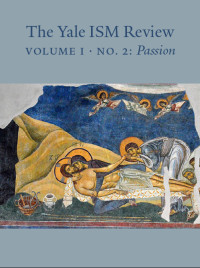Rita Ferrone, editor
The Italian historian of early Christianity, Rainiero Cantalamessa, in his book, The Mystery of Easter, draws attention to a fact that might surprise readers today. Prior to the third century, the Passover of Christ—the Pascha, or what we might call the Easter mystery—was centered on the Passion.
Christ’s death is at the center of the Passover in this earliest period: not the death in itself as a brute fact, but rather as “the death of death,” as “the swallowing up of death in victory” (cf 1 Cor. 15:54). Christ’s death is seen in its irrepressible vitality and saving force, by which, as St. Ignatius of Antioch says, “his passion was our resurrection.”[1]
I thought of this when putting together this issue of The Yale ISM Review, which is organized around the theme of Christ’s Passion. Each of the very diverse contributions offered here bear witness to a kind of irrepressible vitality that resides in the subject of the Passion—a vitality that has awakened responses from artists and musicians, homilists and theologians, writers and poets through the centuries, and continues to do so today.
Our first cluster of contributions is situated in the realm of corporate worship. Teresa Berger’s Good Friday homily was delivered as part of a liturgy in New Haven. Weaving together scripture, human experience, and the iconic spiritual “Were You There,” she makes us stop, look, and be present to the Passion with a keen intensity. Mary Boys then deftly guides us through the light and shadows that surround the difficult subject of anti-Jewish elements in the Passion. She also offers practical suggestions for how to bring into worship a more truly life-giving, pastoral approach to these issues. Finally, the liturgical setting of Bach’s St. John Passion is a palpable presence in Margot Fassler and Jacqueline C. Richard’s splendid 2009 documentary, Performing the Passion, which we revisit in this issue. We have made the whole film available on line, for the first time, along with a study guide.
Next, we step back a bit to reflect on Christ himself, whose identity is both revealed and hidden in his Passion. Who is this Jesus, who was crucified? The subject is explored within the realm of literature—first by Peter Hawkins’s fine discussion of literary portrayals of the Agony in the Garden, and then by Malcolm Guite’s poetry, of which we are pleased to offer two arresting examples: “Jesus Weeps” and “I Am the Door of the Sheepfold.”
Although the visual arts richly communicate “the saving force” of the Passion in a liturgical environment, as our cover art from a twelfth-century Macedonian church shows, they also play an important role in personal devotions, which are found in many and varied cultural guises. The final section of our issue brings us some examples. The Kongo Triple Crucifix, and Cècile Fromont’s trenchant commentary on it, call us to journey to seventeenth-century Central Africa, where the arts and culture of the Kingdom of Kongo engaged with Portuguese Catholicism. Tim Cahill then takes us on a tour through four modern and contemporary “re-readings” of the Stations of the Cross in art, which pass outside traditional religious conventions yet lead us back to the sacred.
In each issue our closing feature—“One Final Note”—cuts across the subject matter of the issue from a different angle, to interrupt our reading in a good way, to provoke a different thought. Our Passion issue ends with a conversation with liberation theologian Jon Sobrino, whose life’s passion (love, desire) has been to take the poor, the “crucified peoples,” down from the cross. He speaks to us from El Salvador, about resurrection.
With gratitude to all our contributors, I commend this issue to our readers as a window onto the “irrepressible vitality” of the Passion.
FOOTNOTE
[1] Raniero Cantalamessa, OFM Cap, The Mystery of Easter, trans. Alan Neame (Collegeville: Liturgical Press, 1993), 12.
